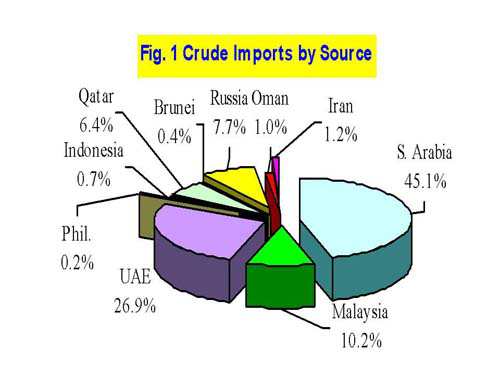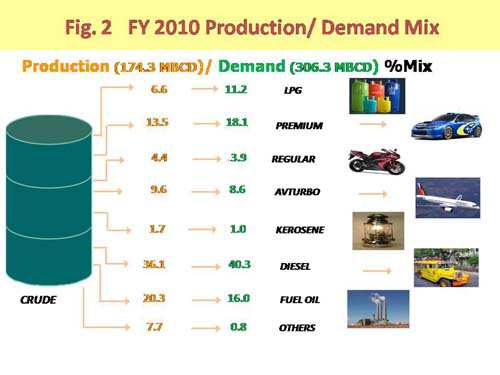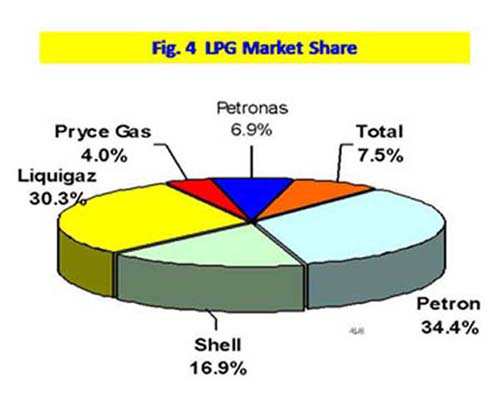SUPPLY
Inventory
Actual total country crudes and petroleum products inventory as of end December 2010 was recorded at 13,821 MB or 46-days supply equivalent, 44 days for crude oil and products in stocks and 2 days in-transit, respectively. This was 18.5 percent higher than last year’s end-December level of 11,666 MB. Full year 2010 average inventory was reported at 53 days, 42 days in stock and 12 days in-transit.
Meanwhile, with the shutdown of the First Philippine Industrial Corporation’s (FPIC’s) White Oil Pipeline (WOPL) since late October of 2010, the operations of Pilipinas Shell and Chevron, which use the pipeline to replenish stocks from their Batangas refinery/terminal to Pandacan depots, were affected. These resulted to shortages of petroleum products, particularly diesel oil and gasoline in some of their gasoline stations in Metro Manila and nearby provinces.
As a backgrounder, the FPIC pipeline was ordered closed in late October by the Makati City government, after the same was found to be the source of the reported petroleum leakage discovered at a condominium located in Makati.
In addition, the Supreme Court issued a writ of kalikasan in November which ordered the closure of the pipeline because of its potential hazard to the environment.
In view of the above, the Department took initiatives/actions to ensure adequacy of supply in the market. One of these, is the activation of the DOE Command Center to direct and coordinate operations and issue communications to the media and the general public for the efficient and effective monitoring and implementation of the oil industry business continuity plan.
To help the affected oil companies, the DOE requested the Metro Manila Development Authority (MMDA) to lift the truck ban in areas under its jurisdiction in Metro Manila, specifically for petroleum tank trucks to increase the turnaround/delivery trips of the existing fleets delivering the petroleum products.
The DOE also intensified its monitoring activities to ensure availability of supply of petroleum products by requiring the oil companies to submit daily inventory reports, as well inspecting several gasoline stations, in particular Metro Manila area.
Note:
As of today, the FPIC pipeline is still out of commission due to the discovery of the leakage and the opposition to its re-opening. However, with several measures adapted both by the oil companies and the government, supply in Metro Manila and nearby provinces is adequately addressed.
Crude Oil Imports
Crude oil imported for the period totaled 67,245 MB, an increase of 33.0 percent vis-a-vis 2009‘s 50,560 MB.
Middle East crudes remained as the country’s major source of crude oil, supplying 80.6 percent (54,232 MB) of the total crude mix while crude from the Far East region (7,806 MB) such as Malaysia, Philippines, Indonesia and Brunei supplied 11.6% of the total crude mix. The remaining 7.7% was sourced from Russia (Fig. 1).
Saudi Arabia remained as top exporter of crude into the country, supplying 45.1 percent (30,359 MB) of the total crude requirement followed by UAE with a 26.9% share (18,088 MB). Next was Malaysia with a 10.2% share followed by Qatar with a 6.4% share.
Petroleum Product Imports
FY 2010 import volume of finished petroleum products dropped by 6.4 percent from 57,843 MB of 2009 to 54,123 MB, which was partly due to high crude import volume and increased refinery production output during the period.
Imports of kerosene/avturbo, LPG, fuel oil, diesel oil and unleaded gasoline recorded decreases of 14.3, 9.0, 6.5, 6.2 and 5.7 percentages, respectively, as compared to year ago level.
The other industry players’ import volume accounted for 51.5 percent of the total import volume, an increase of 23.7 percent from last year’s 22,506 MB to 27,848 MB this year. The oil majors (Petron, Chevron and Shell) accounted for the remaining 48.5 percent with a decrease of 25.6 percent from last year’s level of 35,337 MB to 26,275 MB.
Meanwhile, the local refiners (Petron and Pilipinas Shell) accounted for 25.3 percent of the total product imports while 74.7 percent was attributed to direct importers.
Product import mix were comprised mostly of diesel oil at 41.3 percent, unleaded gasoline at 23.2 percent, LPG at 16.2 percent, fuel oil at 9.6 percent, kerosene/ avturbo at 7.0 percent and other products at 2.7 percent.
Total gasoline import reached 51.0 percent of gasoline demand while diesel oil import was 49.6 percent of diesel demand. LPG import on the other hand, was 69.8 percent of LPG demand. Total product import was 48.4 percent of the total products demand.
The oil majors’ import share in the total demand was 23.5 percent while the other players’ import share was at 24.9 percent. As for the refiners, their import share in the total demand was 12.2 percent, while 36.2 percent was attributed to direct importers.
Moreover, a total of 877 MB ethanol was imported for fuel use during the period. Republic Act No. 9367 of 2007 mandated at least 5% bioethanol substitution of gasoline sales. Philippine National Standards’ PNS/DOE QS 008:2009 for E-Gasoline specified a 10% ethanol content as the existing standard. Thus, gasolines sold in the country are either pure gasoline or E-10 (gasoline with 10% bioethanol content).
Crude Run and Refinery Production
The country’s current maximum working crude distillation capacity is 278 thousand barrels per stream day (MBSD).
Total crude processed increased by 22.7 percent from 53,708 MB to 65,909 MB during the period. The increase could be attributed to lower crude run last year because of the extended shutdown of the local refineries for maintenance.
Vis-à-vis year 2009, the reported refinery capacity utilization improved to 65.0 percent from 52.4 percent only.
Consequently, local petroleum refinery production output also grew by 23.2 percent from last year’s 51,640 MB to 63,614 MB. FY 2010 average refining output was at 174.3 MB per day.
Diesel oil and fuel oil continued to dominate the production mix with shares of 36.1 and 20.3 percent, respectively. These were followed by unleaded gasoline at 18.0 percent, kerosene/avturbo at 11.3 percent, LPG at 6.6 percent and other products at 7.7 percent (Fig. 2).
All petroleum products posted increases vis-à-vis refinery output of 2009 level. Diesel oil refinery output posted the largest increase of 30.9 percent, followed by LPG oil with a 28.1 percent growth. Likewise, fuel oil, kerosene/avturbo and unleaded gasoline refinery output also rose by 19.7, 15.1 and 8.9 percent, respectively.
DEMAND
Petroleum Product Demand
The country’s total demand of petroleum products for the period registered an increase of 4.2 percent from 107,299 MB of 2009 to 111,809 MB. This can be translated to an average daily requirement of 306.3 MB compared with the 2009’s 294.0 MB.
Compared with 2009’s demand, fuel oil recorded the largest increase of 13.4 percent, followed by unleaded gasoline with a 3.5 percent growth. Further, with the full implementation of the bioethanol program, demand for E10 gasoline grew by more than a hundred percent (129%). On the other hand, demand for LPG slightly dropped by 0.1 percent.
Diesel oil grabbed a hefty 40.3 share in the demand mix while unleaded gasoline captured 22.0 shares. Fuel oil and LPG trailed along with a 16.0 and 11.2 share, respectively. Kerosene/avturbo contributed 9.6 percent share in the total demand mix while the other products a mere 0.8 percent (Fig. 3).
Petroleum Product Exports
Total petroleum products exported for the period increased by 7.0 percent from 10,779 MB of 2009 to 11,529 MB.
On a per product basis, condensate, the top exported product in the country, fell by 15.9 percent vis-à-vis last year, same with fuel oil which dropped by 10.4 percent. On the other hand, export of naphtha grew by more than a hundred percent (111.7%). Exports of mixed xylene, benzene, toluene, and propylene also posted increases compared with last year’s level.
The total export mix comprised of condensate (39.9 percent); naphtha (18.7 percent); fuel oil (13.7 percent); propylene (9.4 percent); mixed xylene (7.8 percent); toluene/benzene (7.0 percent; reformate (1.7 percent); and other products (1.7 percent), respectively.
The oil majors accounted for 60.1 percent of the total export mix while the condensate exports of Shell Philippines Exploration B. V. (SPEX) accounted for the remaining 39.9 percent.
Meanwhile, a total of 2,612 MB crude oil (Palawan Light) was exported to various countries during the period, an increase of 36.6 percent from last year’s 1,912 MB.
MARKET SHARE
Total Petroleum Products
The major oil companies (Petron Corp., Chevron Phils. and Pilipinas Shell Petroleum Corp.) got 77.2 percent market share of the total demand, a slight decrease of 1.6 percent from 78.8 percent of 2009.
On the other hand, market share of the other industry players which include PTT Philippine Corp. (PTTPC), Total Phils., Cross Country, Seaoil Corp., TWA, Filpride, Phoenix, Liquigaz, Petronas, Prycegas, Micro Dragon, Ixion Corp. and Jetti as well as the end users who directly imported part of their requirement captured 22.8 percent of the market (Fig. 3).
Local refiners (Petron Corp. and Pilipinas Shell) captured 65.3 percent of the total market demand, while 34.7 percent was credited to direct importers/distributors.
LPG
In the LPG industry, Petron Corp. and Pilipinas Shell Petroleum Corporation’s market shares totaled 51.3 percent while the other players obtained 48.7 percent. Among the other LPG players, Liquigaz got the biggest market share with a 30.3 percent share, followed by Total Petroleum with a share of 7.5 percent (Fig. 4).
OIL IMPORT BILL
Year 2010 total oil import bill amounting to $9.9 billion grew by forty percent compared 2009’s 7.1 billion. This was because of the increased volume of crudes and high import costs of both crudes and finished products during the period as compared to year ago level.
Total oil import cost was made up of 53.8 percent crude oil and 46.2 percent finished products.
Import cost of crude oil amounted to $5.4 billion at an average CIF cost of $79.686/bbl, more than fifty percent higher (59.4%) from 2009’s $3.4 billion at an average CIF cost of $64.741/bbl.
Meanwhile, year 2010 total product import cost increased by 22.8 percent to $4.6 billion at an average CIF cost of $84.946/bbl vis-à-vis last year’s $3.7 billion at an average CIF cost of $80.318/bbl.
The country’s petroleum export earnings rose by 48.4 percent from $0.8 billion last year to $1.2 billion.
Overall, the country’s net oil import bill for the period amounting to $8.8 billion was up by 39.0 percent from last year’s $6.3 billion.




